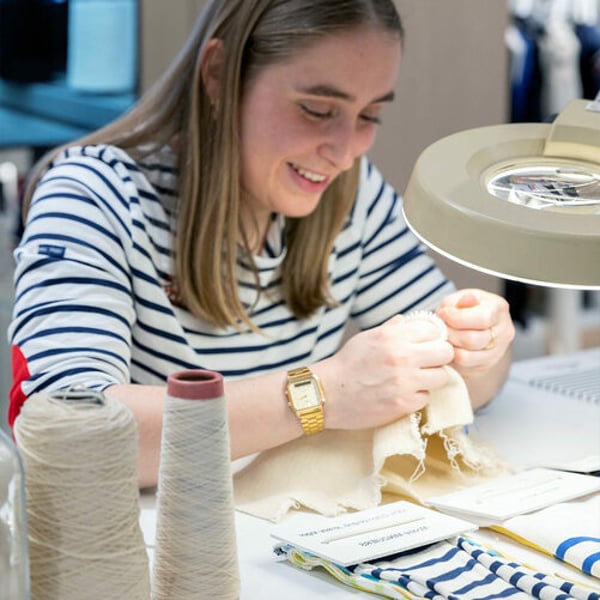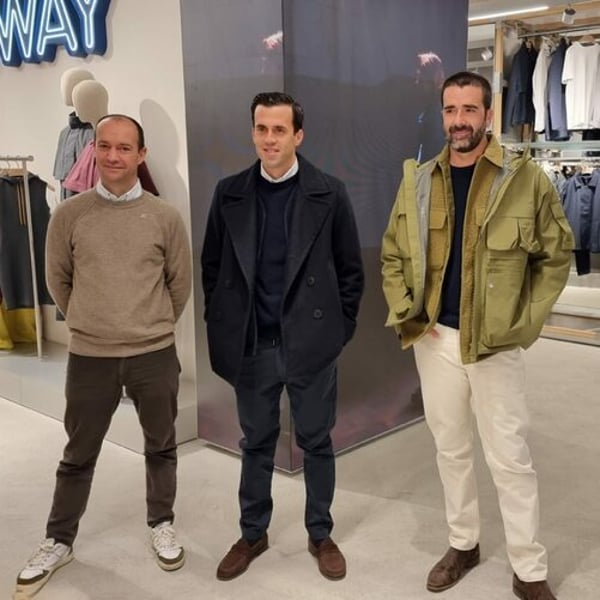Published
November 5, 2025
Fifteen years after French manufacturing became a fixture of public debate, the MIF Expo trade show, held in Paris from November 6 to 9, once again showcases the richness of the country’s clothing and footwear. The show opens the day after the inauguration of a Shein boutique at the BHV, and at a moment when Made in France players seem less shielded from market volatility.

“The Made in France market, which had previously been spared, is now under attack,” explains Luc Lesénécal, CEO of Normandy-based brand Saint James, who points to the direct effects of political and economic instability in France. “I have plans to expand our workshops that have been put on hold because of a lack of clarity and political decisions,” says the Normandy-based executive.
From the Cévennes, Julien Tuffery believes local manufacturing suffers because the negatives are discussed more than the positives. “Customers who only buy Made in France account for 2% of the population. I think this share is growing, but it’s being stifled by the incredible growth in people buying shoddy clothes,” laments the head of jeans brand Atelier Tuffery.
For Patrick Mainguené, director of the Ardèche-based footwear brand Ector, owned by the Chamatex group, the issue goes beyond ultra-fast fashion. “In September, I saw trainers being sold in a supermarket for €4.99,” he says. “That’s the price of our soles. Even if we sourced in Asia, we wouldn’t be able to sell at that price, once you factor in transport, shelf-stocking, storage… You can’t fight on price any more when faced with this kind of pricing, because explaining that a pair costs €120 falls on deaf ears for a large proportion of consumers.”
“It’s time to ask ourselves the real question: do we want to be a nation of passive consumers or a nation of responsible producers?” asks MIF Expo founder Fabienne Delahaye in a press release, recalling the vow of “industrial sovereignty” championed by the Élysée in 2020.
Forget price, champion longevity
At the helm of a century-old company with 200 employees and €70 million in revenue, Luc Lesénécal is alarmed by the accumulation of low-quality products, the standardisation of styles and the short lifespan of items, which are discarded within a year. “We’ll never be competitive on price,” he says. “Some people think they can get by by halving prices, when you’d have to cut them by a factor of ten to make a difference. The strength of Made in France lies in quality and in spreading the cost over years of use, whereas fast fashion won’t last more than two washes.”

Julien Tuffery, whose 42-employee family business now generates €5.2 million in turnover, concurs: “This battle for volume and low prices is lost, probably forever. But I also think it’s this mediocrity that means our battle will be won. The bigger and uglier this great machine becomes, the more room it will leave for alternative paths.”
For Patrick Mainguené, fewer customers are focusing on origin than in previous years. “Made in France comes into play as a buying argument, but it’s not the primary one,” says the shoe manufacturer who, after producing for major brands, launched his own in 2017, making 8,000 trainers a year. “We see it clearly at MIF Expo: what makes people stop is first and foremost aesthetics and comfort. All of us, when we arrive in a shop, first look at the products we like. There’s also a notion of quality associated with French manufacturing. And that’s a point on which we must not disappoint, if we want to build loyalty.”
Materials and manufacturers
Producing in France quickly brings you up against the limited choice of local materials. Beyond cotton, Atelier Tuffery uses 30% wool, as well as linen and local hemp. “We pay very high prices for materials that we could find for a quarter of the price a little further afield. But we have no choice if we want to build a robust supply chain,” explains Julien Tuffery. “And I hope this economic moment, painful for some, won’t wipe out a decade of effort.”

Saint James, which claims to be the last premium brand to produce 70% in France (the remainder coming from Portugal), is careful not to stray from natural materials such as wool and cotton. “In spring 2026, we’ll have our first linen Breton shirt,” reveals its CEO, proud to point out that the yarn will come from the Normandy-based “French Filature”.
“In footwear, the number of manufacturers is shrinking year by year,” stresses the head of Ector. “It’s linked to price differences across Europe, which can vary by a factor of up to three, and that unsettles the market considerably. Many French designers want to produce in France, but end up turning to Spain and Portugal, which have well-equipped factories, whereas in France we mostly have ageing, even obsolete, equipment.”
Controlled growth
The industry members interviewed agree on one point: chasing the Made in France trend too hard risks getting your fingers burnt. “Our foot is permanently on the brake; we turn down high-volume opportunities,” explains Julien Tuffery. “My real professional success will be in 30 years’ time, when I pass on the reins. But doing things well, at volume, at low prices, being sold everywhere, delivering on CSR, all that with rapid growth—it’s an equation I can’t solve, and I think it’s unsolvable.”

Even with a history dating back to 1889, Saint James refuses to grow too big too fast, while noting 60% growth over the last twelve years. “We limit our growth to 5% a year, because our production facilities have to keep up,” says its CEO, who has been investing for three years in modernising around a hundred knitting machines. “And we need to keep a balance between export markets, because you never know when a Brexit-style shock or a US tariff might land.”
While French fashion shines worldwide through its maisons, the products of its local manufacturers do not enjoy the same aura with foreign customers and distributors. “I’ve just come back from Japan, and whether it’s Made in France or Italy makes no difference to them. It brings a good dose of humility,” smiles Julien Tuffery. Patrick Mainguené tempers this: “Abroad, there’s an attraction for Made in France if it conveys heritage, as is the case with our Breton shirts and sailors’ jumpers.”
Training and public procurement
The challenges of local production are intrinsically linked to those of skills, which have become scarcer since the offshoring of the 2000s. From Atelier Tuffery to Saint James via Ector, this pitfall is addressed through in-house training. At Saint James, it takes 18 to 24 months to train someone for a position, while Atelier Tuffery relies on the versatility of its employees and on a welcoming production environment, firmly breaking with the image of the factories of yesteryear.

“People coming out of training have a basic knowledge that saves us time, but above all it’s their desire to do the job that’s decisive,” explains Patrick Mainguené. “Students spend only a short time in the workshop, and have a limited view of the industrial side. So we have to take the time to train them in-house. Without that, there’s no French manufacturing.”
Like training, public procurement is also inseparable from discussions around Made in France. “In the US, 50% of contracts are reserved for American manufacturers. So we also need our public procurement to favour Made in France,” says Luc Lesénécal, who generates 5% of the company’s revenue with the armed forces. “Beyond supporting reshoring, we should start by promoting those who, like us, have never offshored.”
This article is an automatic translation.
Click here to read the original article.
Copyright © 2025 FashionNetwork.com All rights reserved.







